
Journal of Science and Transport Technology Vol. 4 No. 3, 24-38
Journal of Science and Transport Technology
Journal homepage: https://jstt.vn/index.php/en
JSTT 2024, 4 (3), 24-38
Published online 08/09/2024
Article info
Type of article:
Original research paper
DOI:
https://doi.org/10.58845/jstt.utt.2
024.en.4.3.24-38
*Corresponding author:
Email address:
binhpt@utt.edu.vn
indra52prakash@gmail.com
Received: 25/06/2024
Revised: 11/07/2024
Accepted: 10/08/2024
Geotechnical Forensic Investigations of a
Gravity Dam: Addressing Seepage and
Sliding Problems in the Basalt Foundations of
Karjan Dam, Gujarat, India
Indra Prakash1* & Binh Thai Pham2*
1DDG(R) Geological Survey of India, Gandhinagar, Gujarat 382010, India;
indra52prakash@gmail.com
2University of Transport Technology, 54 Trieu Khuc, Thanh Xuan, Ha Noi,
Vietnam; binhpt@utt.edu.vn
Abstract: Geotechnical forensic engineering plays a crucial role in identifying
and mitigating potential issues in large gravity dams. The Karjan Dam in
Gujarat, India, a 100-meter-high gravity dam built 38 years ago on Deccan
basalt, encountered significant geotechnical challenges during construction
due to early investigation oversights. These oversights failed to detect sub-
horizontal weathered rock seams within the basalt during the pre-construction
investigations, which could have posed significant seepage and sliding risks
during the dam's operation. Subsequent detailed investigations during the
construction phase revealed that these seams extended throughout the
foundations of the dam blocks.
In-situ shear tests were conducted to determine the shear parameters, namely
cohesion (C) and the angle of internal friction (ϕ) of the seams. The test results
indicated low shear strength parameters, necessitating a re-evaluation of the
dam's safety. Stability analysis revealed that the spillway and certain non-
overflow blocks were at risk of sliding and seepage after reservoir filling. To
address these geotechnical challenges, a combination of treatments—
including concrete shear keys, grouting, and design enhancements—was
implemented to prevent sliding and control seepage. The timely forensic
investigation and treatment during the construction stage ensured the dam's
safety, which has operated without issues since 1986.
This study underscores the critical importance of integrating engineering and
geological assessments at various stages of dam construction. Re-evaluating
and addressing evolving foundation conditions, particularly during
construction, is essential for applying effective treatments to prevent dam
failure during operation. The findings from this case study provide valuable
geotechnical insights required for enhancing the safety and resilience of dam
infrastructure globally.
Keywords: Geotechnical forensic study, Weathered Rock seams, Concrete
Shear keys, Basalt foundation, Seepage and sliding, Dam failure prevention.
1. Introduction
Dams are vital for water storage, flood
control, irrigation, and hydroelectric power.
Ensuring their safety requires comprehensive

JSTT 2024, 4 (3), 24-38
Prakash & Pham
25
geotechnical investigations during design,
construction and post construction phases.
Geotechnical studies are essential at various
stages of dam projects to ensure stability, safety,
and longevity. During the Investigation Stage,
comprehensive site investigations are crucial.
These include geological mapping, drilling
boreholes, and collecting soil and rock samples for
laboratory testing to determine physical and
mechanical properties [1]. Geophysical surveys
such as seismic refraction and electrical resistivity
are also conducted to assess subsurface
conditions [2]. Hydrogeological studies to
understand groundwater flow and its potential
impact on the dam structure are equally important
[3]. During the Construction Stage, continuous
geotechnical monitoring is vital. This involves
progressive examination and evaluation of
foundations, in-situ testing of excavated rocks and
associated weak features to detect any deviations
from the initial investigations [4]. Instrumentation
like piezometers, inclinometers, and settlement
gauges are to be installed to monitor pore water
pressure, deformation, and settlement during
construction [5]. In the Post-Construction Stage,
continuous geotechnical monitoring and
maintenance are imperative to detect and address
any emerging issues. This includes periodic
inspections, continued evaluation of installed
instrumentation to monitor changes over time, and
reassessment of structural stability and foundation
conditions [3]. Post-construction studies also
involve evaluating performance of the dam during
and after major events like earthquakes or floods
to ensure that the structure remains safe and
functional [2]. Regular updating of geotechnical
data and revising safety measures based on new
findings and technological advancements is also
recommended [1].
Gravity dam failures can result from a
combination of structural, hydrological, geological,
operational, environmental, and human factors.
Structural issues may include weak foundations,
poor material quality, design flaws, and
construction errors, all of which can compromise
the dam's integrity [2]. Hydrological causes such as
overtopping, extreme flooding, and inadequate
spillway capacity can lead to severe stress on the
structure [3]. Geological instability, including
seismic activity and erosion, can further weaken
the dam foundation ad structure [1]. Operational
failures often stem from poor maintenance,
improper handling of dam controls, and insufficient
monitoring [4]. Environmental factors, such as
extreme weather events and sedimentation, can
exacerbate these issues [5]. Additionally, human
activities, including vandalism, sabotage, and
improper land use, can directly or indirectly
contribute to dam failure [3]. Recognizing and
addressing these potential causes are essential for
ensuring the safety and longevity of concrete
dams.
The failure of a dam can result in catastrophic
consequences, including loss of life, environmental
damage, and economic loss. Geotechnical forensic
studies are essential for understanding the
underlying causes of dam failures and for
developing strategies to prevent future incidents.
The case study of 100m high masonry-cum-
concrete gravity Karjan Dam, Gujarat, India
provides insights into potential challenges posed
by basalt rocks and associated features such as
sub-horizontal weathered rock seams in the safety
of structures and their adequate solutions. The
timely geotechnical forensic investigation at the
Karjan Dam site during-construction stage of the
dam ensured safety of the dam, which has been
operating without issues since 1986 [6]. The main
objective of this forensic study is to review the
geological and geotechnical conditions of
foundations in light of sub-horizontal concealed
weak geological features likely to be overlooked
during initial investigations, as in the case of the
Karjan Dam, in order to provide timely treatment
and ensure the safety of the structure.
2. Study Area

JSTT 2024, 4 (3), 24-38
Prakash & Pham
26
The Karjan Dam (21.7834° N, 73.5329° E) is
situated near Jitgadh village in Nanded Taluka,
Narmada District, Gujarat. It spans the Karjan
River, a left-bank tributary of the Narmada River,
which joins the Narmada downstream of the Sardar
Sarovar Project. The Karjan Dam is located
approximately 25 km downstream of the Sardar
Sarovar Dam, in the Lower Narmada Valley, a rift
zone (graben) defined by faults aligned parallel to
the Narmada-Son lineament (NSL) zone in the
ENE-WSW direction (Fig. 1).
2.1. Salient Features of the Dam
The Karjan Dam, completed in 1986, is a
masonry-cum-concrete gravity structure stretching
911 meters in total length, with its crest level at
101.23 meters and a full reservoir level (FRL)
reaching 115.25 meters. The dam's top stands at
an elevation of 119.70 meters, and it reaches a
maximum height of 100 meters from the deepest
foundation level. The spillway, a concrete structure
spanning 171.61 meters, features a gated, ogee-
shaped crest equipped with nine radial gates, each
measuring 15.55 meters by 14.20 meters, and
includes a stilling basin with a horizontal apron and
a flip bucket for efficient energy dissipation [6] (Fig.
2). The dam also incorporates non-overflow
sections on both the left and right banks,
constructed of masonry, along with spillway blocks
made of concrete. Work of right and left bank main
canals was completed in 1991 and 2000,
respectively. A small powerhouse with a 2 MW
capacity is situated on the left bank of the Karjan
Dam.
2.2. Geology of the Dam Site
Karjan Dam is situated in the Lower Narmada
Valley on Deccan basalt flows within a rift zone
(graben) delineated by faults aligned in the ENE-
WSW direction [6,7]. The basalt flows at the dam
site are classified into two types: "Aa" and
"Pahoehoe". Aa flows, found at higher levels on the
abutments, exhibit a transition from fine-grained or
porphyritic dense basalt at the base to an
amygdaloidal or tuffaceous composition at the top,
with individual flow thicknesses varying from 4 to
10 meters. Pahoehoe flows in the river section are
characterized by a wrinkled (ropy) and vesicular
top, containing pipe amygdales at the base, with
each flow unit typically measuring between 3 to 5
meters in thickness. A notable geological feature in
the area is the presence of weathered rock seams
at the interfaces of these flows, which have
contributed to challenges related to seepage and
sliding of dam blocks [8].
2.3. Weathering of Basalt and Development of
Weathered Rock Seams:
Weathering is a multifaceted process
involving the breakdown and decomposition of
rocks within their natural environment [9]. In basalt
formations, this process alters both mineral
composition and chemistry, influenced significantly
by the rock's inherent mineralogy, joints, and
fractures. Certain minerals found in basalt, such as
olivine and pyroxene, are particularly susceptible to
weathering, which can weaken the overall strength
and durability of the rock. Weathered rock seams
develop between basaltic flows after they cool,
primarily along the contact zones of layered basalts
[8]. These seams form as water percolates through
open or sheared contacts within the rock. Unlike
red or green bole layers, weathered rock seams do
not indicate breaks in deposition over time; instead,
they signify zones of intense weathering and
alteration.
Characteristically, weathered rock seams
consist mainly of highly to completely weathered
basalt, often accompanied by a thin layer of clayey
material. These seams exhibit a distinct
morphology with a wavy, branching pattern that
includes areas of pinching and swelling (Fig. 4).
Their thickness varies significantly, ranging from a
few millimeters to 1.5 meters. In some cases,
infillings of minerals like zeolite or calcite are
observed within these seams. Slickensided
surfaces along these seams suggest localized
movements and displacement, identifying them as
potential weak planes vulnerable to structural

JSTT 2024, 4 (3), 24-38
Prakash & Pham
27
instability, such as sliding in dam blocks.
Understanding the intricate processes of basalt
weathering and the formation of weathered rock
seams is crucial for assessing the geotechnical
challenges posed by such formations in civil
engineering and construction projects [10].
Fig. 1. Location Map of the Karjan Dam
Fig. 2. Spillway of Karjan Dam under operation
Fig. 3. Weathered Rock Seam developed along the contact of two flows (Adopted from [10])

JSTT 2024, 4 (3), 24-38
Prakash & Pham
28
2.4. Physico-engineering properties of the
foundation rocks
The physico-engineering properties of the
foundation rocks including specific gravity, water
absorption, porosity, permeability, unconfined
compressive strength and tensile strength were
determined. The average values of water
absorption percentage vary from 1.60 to 2.20,
porosity 4.20 to 5.15, specific gravity 2.58 to 2.70,
unconfined compressive strength 62 to 79 MPa,
tensile strength 10 to 12.50MPa and permeability 0
to 2.73x10-9cm/sec. These values are within the
normal limit of fresh, moderate to good values of
basalt [11] (Fig. 4).
Fig. 4. Varied Characteristics of Weathered Rock Seams in Basalt Foundation

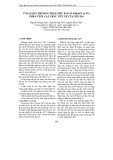
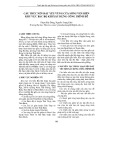
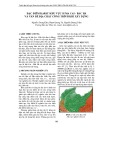
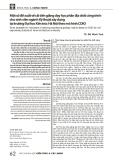
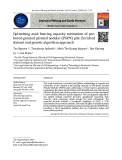
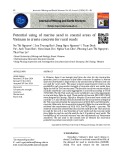
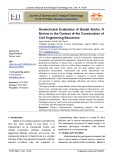










![Bài giảng Quản lý vận hành và bảo trì công trình xây dựng [chuẩn nhất]](https://cdn.tailieu.vn/images/document/thumbnail/2025/20251006/agonars97/135x160/30881759736164.jpg)







